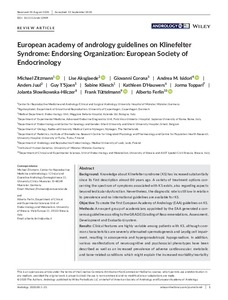European academy of andrology guidelines on Klinefelter Syndrome: Endorsing Organization: European Society of Endocrinology
Michael Zitzmann; Lise Aksglaede; Giovanni Corona; Andrea M. Isidori; Anders Juul; Guy T'Sjoen; Sabine Kliesch; Kathleen D'Hauwers; Jorma Toppari; Jolanta Słowikowska-Hilczer; Frank Tüttelmann; Alberto Ferlin
European academy of andrology guidelines on Klinefelter Syndrome: Endorsing Organization: European Society of Endocrinology
Michael Zitzmann
Lise Aksglaede
Giovanni Corona
Andrea M. Isidori
Anders Juul
Guy T'Sjoen
Sabine Kliesch
Kathleen D'Hauwers
Jorma Toppari
Jolanta Słowikowska-Hilczer
Frank Tüttelmann
Alberto Ferlin
WILEY
Julkaisun pysyvä osoite on:
https://urn.fi/URN:NBN:fi-fe2021042826033
https://urn.fi/URN:NBN:fi-fe2021042826033
Tiivistelmä
Background Knowledge about Klinefelter syndrome (KS) has increased substantially since its first description almost 80 years ago. A variety of treatment options concerning the spectrum of symptoms associated with KS exists, also regarding aspects beyond testicular dysfunction. Nevertheless, the diagnostic rate is still low in relation to prevalence and no international guidelines are available for KS.
Objective To create the first European Academy of Andrology (EAA) guidelines on KS.
Methods An expert group of academicians appointed by the EAA generated a consensus guideline according to the GRADE (Grading of Recommendations, Assessment, Development and Evaluation) system.
Results Clinical features are highly variable among patients with KS, although common characteristics are severely attenuated spermatogenesis and Leydig cell impairment, resulting in azoospermia and hypergonadotropic hypogonadism. In addition, various manifestations of neurocognitive and psychosocial phenotypes have been described as well as an increased prevalence of adverse cardiovascular, metabolic and bone-related conditions which might explain the increased morbidity/mortality in KS. Moreover, compared to the general male population, a higher prevalence of dental, coagulation and autoimmune disorders is likely to exist in patients with KS. Both genetic and epigenetic effects due to the supernumerary X chromosome as well as testosterone deficiency contribute to this pathological pattern. The majority of patients with KS is diagnosed during adulthood, but symptoms can already become obvious during infancy, childhood or adolescence. The paediatric and juvenile patients with KS require specific attention regarding their development and fertility.
Conclusion These guidelines provide recommendations and suggestions to care for patients with KS in various developmental stages ranging from childhood and adolescence to adulthood. This advice is based on recent research data and respective evaluations as well as validations performed by a group of experts.
Kokoelmat
- Rinnakkaistallenteet [27094]
